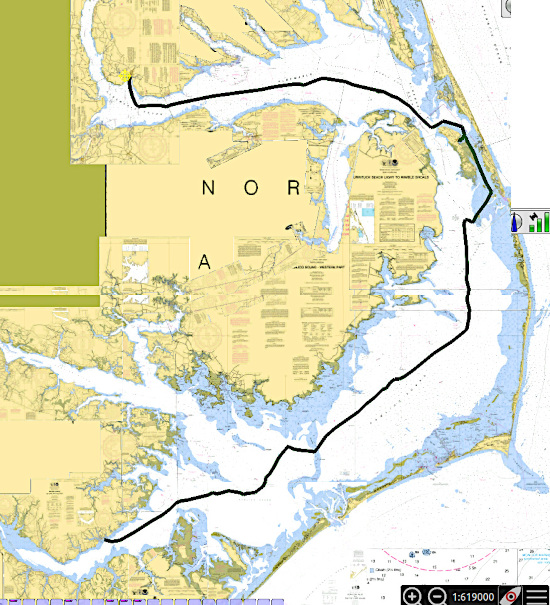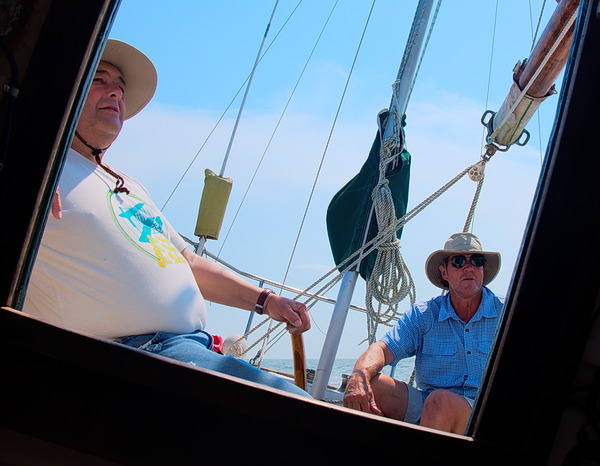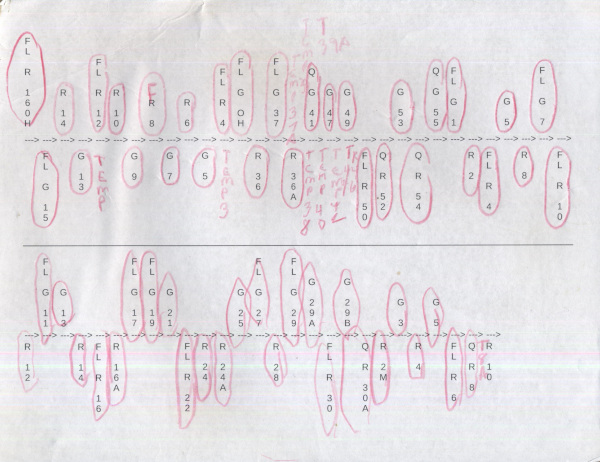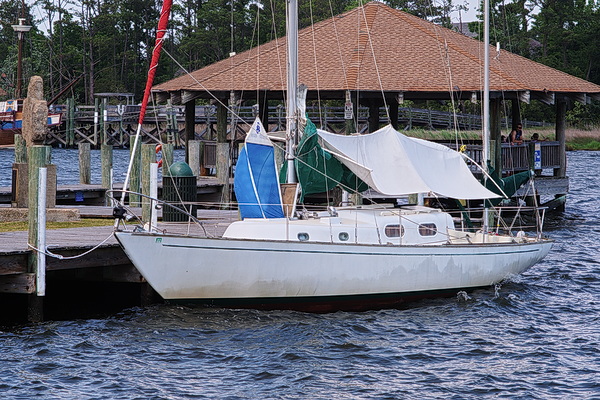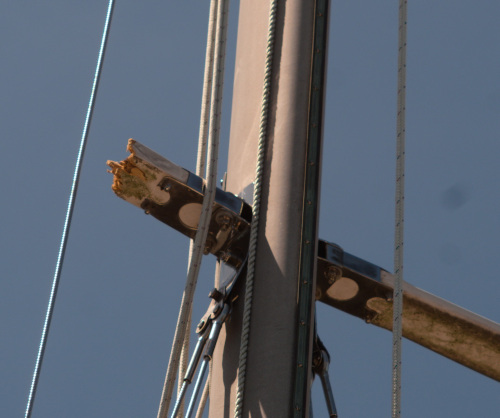Oriental to Edenton, By Way of Manteo
Text and Photographs by Paul Clayton
With a new Beta 20 replacement for the Atomic 4, it was time to go back to Edenton on the Albemarle. Taylor Ward, who crewed for me on the trip to Oriental, had stayed in touch and assured me of his interest in making the return trip. David Swanson, sometime writer for Neuse River Sailor, also expressed an interest. It was to my great benefit that I was able to make arrangements so both of them could come.
The Beta would have made the standard route up the ICW by way of the Alligator-Pungo Canal less nerve-wracking than with the sometimes unreliable Atomic 4, but I had long had a hankering for running up the Pamlico Sound overnight and following the Old House Channel - Roanoke Sound route into Manteo. Anchorages on the upper Pamlico Sound are few and far between, but with crew it would be possible to make an overnight voyage and be positioned at the mouth of Old House Channel to take advantage of the rising tide and light morning airs.
The route I plotted on OpenCPN showed 71 miles (all distances in nautical miles) from Oriental to the mouth of Old House Channel. I calculated that if we left Oriental by noon, we would reach Old House by 2:00 AM the following morning, at 5 knots. That would leave about 5 hours of padding in case we ran slow, so that we could enter the channel at 7:00 AM, shortly after sunrise. If all went well, we would be in Manteo before noon, and have the whole afternoon and evening to enjoy ashore. The following morning we would continue on to Edenton, which would be a long day. This plan was dependent on weather, as the common knowledge had it that the channels between the Pamlico Sound and Manteo were problematic in northeast winds, as the water blew to the south end of the sound and got shallow at the north. On the other hand, south winds piled water up at Roanoke Island, reflecting off the shore and producing an ugly chop that could make it hard to stay in the channels. Light winds from any quarter shouldn't be a problem.
Even the most cursory appraisal of the route through the channels showed an enormous number of markers including three inbound-outbound reversals, especially easy places to lose track of the boat's location. To give us the best chance I made up a diagram of the charted markers - all 58 of them - listing them in sequence to port and starboard. A couple of days before our trip I ran into friends Dale an Cori of Hi-Flite, experienced blue water cruisers, who told me they had run up the sound from Ocracoke to Manteo a couple of years ago and had no problems in the channels. This was a great encouragement.
I arrived at Deaton's yard in Oriental a few days in advance and spent time getting the boat ready and visiting with Matthews Point friends. Dan was anchored in Greens's Creek and dinghied in to join me for a beer at the New Village brewery. Afterwards I showed him the Beta installation in Terry Ann and he pronounced it good. The trip was planned for the days leading up to Memorial Day weekend so that Taylor and David would have some slack to get back to work on time if we got delayed - always a possibility with sailing. As they say, sailboats have destinations, not ETAs.
I drove to Edenton on Wednesday to position my car at the marina, and Taylor arrived mid-afternoon after a short day at work. We rode in his truck to Oriental and had some time in the evening to get gear packed away. David drove down from Cary after work and spent the night on his Stone Horse at Pecan Grove. In the morning, Taylor went to pick up David. I had told David to watch for someone in a black F150. Unfortunately, Taylor drives a GMC. After a few laps around Pecan Grove, Taylor asked a random person standing near the road if he might be David, and got the response, that yes, he might be. I was chaffed unmercifully for the next several days about not knowing the difference between a Ford and a GMC.
My plan was to leave Oriental by noon, and in fact we got off the dock at 9:45. Even with the dredging of Whittaker Creek, completed about a year ago, it was tricky getting out the channel. As of May 2021, the drill is to stay well out on the red side of the channel while passing floating can 3A. There should be at least six feet of water. Elsewhere there is at least seven feet if you are careful to stay in the channel.
Out on the river I passed the tiller to David and told him to hold a course downriver. He is an experienced Neuse River sailor, and took us well out into the center of the river, laying a direct course for marker "NR" and avoiding the ICW traffic which favors the north bank. Taylor and I rolled out the jib, and with the motor running at 2700 rpm, 75% of full throttle, we were soon moving at 5.75 knots. The wind didn't last, and by the time we passed "NR" at 11:20 we had rolled in the jib.
We motored out across the sound, passing "BI" at the end of Brant Island Shoal at 2:10. The weather forecast called for southeast winds of five to ten knots becoming south, but we found persistent east by northeast winds of 10-15 knots. Hoping the wind would veer as the day went on, we raised the main, rolled out the jib, and shut down the motor. With a clean bottom and careful sail tending we were able to sail a few degrees east of north, but not enough to clear "Seven Foot Patch" on Bluff Shoals, so after a little over an hour we dropped sail, started the motor and made a couple miles easting back to our planned course.
Late in the day the wind veered enough to get the jib back up, and we motor-sailed as the sun set. After dark, the wind dropped, so we rolled in the jib and motored north. All day long we had been taking two-hour watches at the tiller. Taylor was napping in his berth and David was in the cockpit keeping me company as I manned the tiller. The first star visible was almost directly ahead and provided a perfect point to steer by.
My watch ended and I went below to nap. Taylor came on deck to sit with David as he took the tiller. The stars were out in profusion and the Hatteras light was visible off the starboard quarter.
When I came back on deck after an hour of sleep, Taylor innocently asked me how to get the chart plotter to switch to the next map. I took a look and could see the configuration was messed up, so I took the plotter below deck to work on it at the table. Eventually I got the chart quilting working again and brought the plotter back on deck, saying "you boys stop playing with the plotter while daddy is asleep." David denied even touching it so I decided it must have been Taylor's doing.
In a while the moon came up, just a few days past full, and obliterated the starry sky. Bodie Island Light was visible off the starboard bow, and the lights of Wanchese and Manteo started to appear ahead.
At 2:00 AM we reached Marker 16OH, the entrance to Old House Channel. We put down the anchor to the north of the channel. Taylor and David went to their berths. I would do anchor watch until 4:00 and then call David. When 4:00 came, David was sleeping soundly. Since the wind had dropped to just a few knots, the anchor was holding soundly, and there was no traffic, I decided to let him sleep. I laid out in the cockpit and caught some zees myself.
At 6:00 David came on deck, chastised me for not waking him at 4:00, and pointed out a rain shower approaching from the southwest. Then he added some gratuitous comments about my sleeping arrangements - "Pitiful. Poor Paul, sleeping in the cockpit on two throwable cushions with a fender for a pillow". Taylor came crawling out of his den in the forepeak, in the half-light of dawn looking like a large sleepy bear. It took us just a few minutes to start the engine and get the cockpit straightened out. I pulled up on the anchor and broke it out from the clean sandy clay bottom and we motored into the channel. Taylor took position on the bow, calling each marker, I marked them off as we passed, and David steered.
We didn't meet any traffic in Old House Channel, but from the junction with Walter Slough, which runs out to Oregon Inlet, on through Roanoke Sound, we passed a procession of boats, mostly large sport fishermen outbound. The upper part of Old House Channel and the corner at Walter Slough boasted a profusion of floating temporary markers to supplement the fixed ones. We had no trouble navigating the area, and didn't even see shallow water. Likewise, the run up Roanoke Sound gave us no difficulties. So much for the fearsome reputation of the Manteo route.
We tied up at the Manteo Public Dock at 10:00 AM, within sight of the Elizabeth II replica of an Elizabethan era square-rigged ship, and the replica of the Roanoke Marshes lighthouse. David went off exploring while Taylor and I had rum and cokes to celebrate and then set up the big awning to keep the boat cool. Taylor called his wife Gail to tell her we were safe on the Manteo docks and drinking rum and cokes at 10:00 in the morning.
The wind was blowing straight in to the dock and getting stronger. This Memorial Day weekend, crowds of people were walking the Manteo waterfront. An occasional light power boat would come in and dock near us while the captain and crew went to one of the local restaurants for lunch. Mobs of teenage girls would ride by on bicycles and disappear screaming into the distance.
Taylor took off and I lay down below deck for a nap. After a while we all gathered at the boat and I announced that I was going in search of diesel fuel. David pulled out his smart phone, did some googling and announced that Shallowbag Bay Marina would be the best bet. He called them and verified they had diesel, and I got ready to make the hike. Taylor volunteered to join me, and I gratefully accepted. David planned to get some shut-eye, but at the last minute decided he would come along too. So that is how three late-middle-aged men, varying from "carrying a few extra" (Taylor) to "starting to pack it on" (David) to "grossly overweight" (myself), set out along the streets of Manteo in the hot sun lugging a five-gallon fuel can.
Out on Highway 64, we passed the Speedway on the other side and continued onward. A somewhat addled man bicycled up from behind and joined our procession for a few minutes. He needed to cross the road and was getting no chances with the endless stream of traffic running 35-40 mph. Eventually he went on ahead, still looking for a chance to cross. He finally made a risky bolt for it, as he had run out of room to lee - the ABC store was directly across the road. We came to Shallowbag Bay Marina, fortunately on our side. The owners were avid, experienced sailors and we had a good visit with them. Out of respect for our backs, I only filled the can to three gallons, which would give us ample reserves to make Edenton. We alternated carrying the can on the way back and nobody suffered too much.
The new fuel tank on Terry Ann holds 21 gallons of fuel, enough for 42 hours of motoring. The three gallons we added brought us up to 15 gallons, more than enough to motor to Edenton if we had to. The forecast for the following day was a small craft advisory for the Roanoke and Croatan Sounds, with a southwest wind. In the Albemarle, southwest winds of 15-20 were expected, clocking around to north later in the day. Out of respect for the small craft advisory, we tied a reef into the main on the dock at Manteo.
Somebody suggested we find a place for dinner. I was willing to cook on the boat, but quite happy to let somebody else cook while we sat in air conditioning. So, all in agreement, we walked around looking at restaurants, some closed, some with long lines, until we found the Lost Colony Brewery and Cafe. The outdoor seating was crowded but there were plenty of tables available inside, which suited us. I had a delicious plate of black beans and rice while the crew had bar food served in a nouvelle cuisine fashion. Taylor and David split the tab, which the captain appreciated.
In the morning we cast off and motored out of Shallowbag Bay to the channel. We took out a few rolls of jib and motorsailed around Roanoke Island, then raised the reefed main, rolled out some more jib and shut down the engine for a nice sail out into the Sound. By the time we crossed the ICW route between Camden Point and the mouth of the Alligator River, the wind had dropped off, so we shook out the reef and rolled the jib out the rest of the way. This proved to be a mistake.
Dark, threatening clouds were brewing up in the west. I listened to the weather radio for the local area, which reported thunderstorms likely, but didn't call for any hazardous weather. I should have trusted my eyes and gut feeling and dropped the main, but Terry Ann has ridden out many a gusty thunderstorm hove-to, and I expected this one to be just another.
Suddenly the winds picked up and we tried to round up. A blast of wind, probably 50 knots, came across the water, accompanied by short, steep waves and lashing rain. The bow fell off and Terry Ann laid over on her port side. I called to David at the helm to drop the main sheet, which he was already in the process of doing. The boat came back up, but the jib was streaming out in the wind. The sudden blast of wind on the few feet of jib that we were carrying had been enough to rip the cleat holding the furling line out of the combing, allowing the sail to completely deploy. The grommet at the clew had ripped out and the sheets had vanished in the wind.
The first thing to do was to drop the main. I went forward to the mast and uncleated the halyard, and as the sail dropped Taylor corraled the thrashing canvas and got ties on it. The main boom was drooping down toward the cockpit but high enough on the topping lift to deal with, so David sheeted it in tight amidships. With the engine running and David at the helm, Taylor and I worked to get the jib in. About this time David looked up the mast and called to us that the port spreader was broken. I called back to maintain a starboard tack which David already knew to do. It was a scary sight to look up the mast and see the length above the lower shrouds whipping back and forth in the wind. Taylor and I worked together on the thrashing bow to get the jib down and the jib halyard set up to the port upper chainplate, which stabilized the mast.
By this time the wind and waves had died down, though it remained choppy on the sound. It was getting colder by the minute, and after a while it started to rain. The Atomic 4 had run better with more ventilation, and we had made a screen frame to fit in place of the counter that ordinarily covered the engine to allow for air flow. Now I put the screen in place, and each of us took a turn standing below deck soaking up the heat coming off the Beta. By the time we reached Edenton, the rain was lashing down from due north, the wind was blowing and it was getting dark. We followed the markers into the bay and turned in to the protected town dock, where a friendly fellow sailor from a neighboring trawler helped us set our lines. With the rain and cold, nobody felt like walking into town for dinner, so we cooked something on the boat and were all in our berths early.
In the morning we motored the short two miles to the marina and backed in next to Tom and Ann's Sea Wasp. Phil came out to catch our dock lines and later, at his most cordial, had us all aboard Oryoki for coffee. Afterward, we packed my car and headed for Oriental, where I dropped Taylor and David at their vehicles. They headed to their homes, while I drove back to Edenton and spent a couple of days getting Terry Ann in order before returning home myself.
The experience of running up the Pamlico Sound and following the channels into Manteo was a first for all three of us, as was getting knocked down on the Albemarle. Having crew made the trip much easier, safer and more enjoyable for me. I hope Taylor and David will sail with me again, and I have an idea that they might.
Text and Photographs by Paul Clayton. Posted 06/18/21.
Copyright © 2021 Paul M. Clayton
